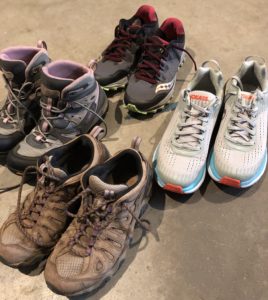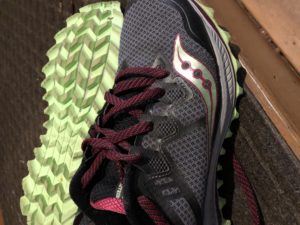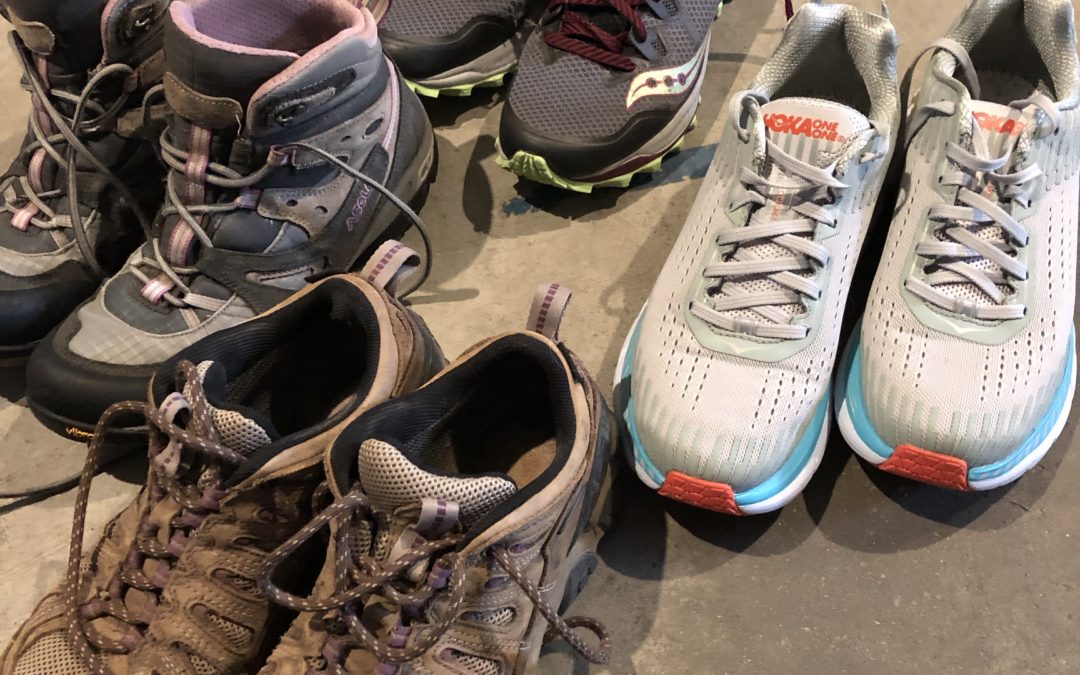 One question I’m frequently asked is what kind of footwear I recommend for hiking – namely, shoes or boots.
One question I’m frequently asked is what kind of footwear I recommend for hiking – namely, shoes or boots.
If you poll 100 hikers about their chosen footwear, you’ll get 100 different, impassioned answers. People are so sure they have found the magic hiking footwear. But really, it comes down to your own two feet. You need to hike in whatever footwear you find the most comfortable.
That being said, there are several things to consider when pondering the footwear you’ll use on a given trail. Here are some of them.
What Is the Trail Like?
Before setting out on a hike, learn as much as possible about the trail you’ll be on. Will you be walking through a lot of water? Then you may wish to wear waterproof boots or shoes. Will there be a lot of sand or gravel? Perhaps you’ll prefer footwear with a higher cut, or with a leather versus a mesh upper.
I recently completed the Arizona Trail. Many sections were incredibly rocky. The rocks quickly shredded the bottoms of the running shoes I wore, causing me to repeatedly fall. I switched to my hiking boots, and their tougher soles withstood the rocks much better. I stayed upright.
However, the hiking boots were more firmly constructed and not as bendable. As my feet slid around on the rocks, my toes had nowhere to go inside the confines of my boots except on top of one another. This caused many blisters and one very painful corn. I then switched to trail runners, which combined tougher soles with flexible uppers. Problem solved.
But remember, there is no magic answer. If you had been hiking with me on the Arizona Trail, your feet might have done very well in stiff boots.
Waterproof vs. Breathable
Waterproof boots are good at keeping your feet dry. So if you’ll be hiking through a lot of water, you may prefer these. But keep in mind that your feet will still get at least a little wet in waterproof boots, namely from your feet sweating. Once your feet become damp or wet in waterproof boots, they will become susceptible to blisters and other ailments.
The boots themselves can also become wet from moisture in the air, sweat running down your legs, rain, etc. And once waterproof boots  become wet, they take a long time to dry out.
become wet, they take a long time to dry out.
If you’ll be hiking in the winter in waterproof footwear, take extra care. One friend of mine ran a trail race on a frigid, snowy day in waterproof shoes. Her feet sweat, and that condensation turned to ice that coated her toes because it could not escape the shoes. She suffered frostbite as a result.
Breathable shoes are lighter weight than waterproof footwear. And their breathability means they will let water right in. Your socks and feet will definitely get wet the minute you cross water, it begins to rain, etc. However, this type of footwear will also dry out quickly.
I prefer breathable shoes. My friend loves her waterproof boots. Just remember that if you select the latter, bring along extra socks and change them frequently during the day.
Shoes vs. Boots vs. Really Big Boots
In the past, people generally donned boots for hiking in rocky, mountainous terrain. If your chosen trail was flat or merely hilly, with decent footing, athletic shoes – and namely running or trail shoes – were typically favored. This practice is changing.
More and more hikers are opting to hit the trail in athletic shoes. In addition, athletic shoe companies such as Hoka One One are creating more trail-friendly footwear. If your feet do well in regular running shoes, opt for those. Breathability and flexibility are wonderful assets, as noted above. Plus, athletic shoes are lighter. Some experts say it’s better to have weight on your back than on your feet.
If you need sturdier shoes or high-tops due to ankle issues, then look for those. Or follow in my husband’s footsteps. Ed turns his ankles easily, so if the terrain is tough he wears ankle braces with his running shoes.
Socks Matter
This article focuses on shoes versus boots, so I’m not going to delve into socks at this time. Just know that you need to pair your footwear with appropriate socks. I’ll discuss this in another post.
Use Gaiters
A final piece of advice: No matter your choice of footwear, always pair with gaiters. Gaiters are pieces of fabric that you slip over your shoes or boots to keep out rocks, sand and grit. I like these sold by Gaiter Pods on Etsy, as they’re lightweight, easy to use and work well.




